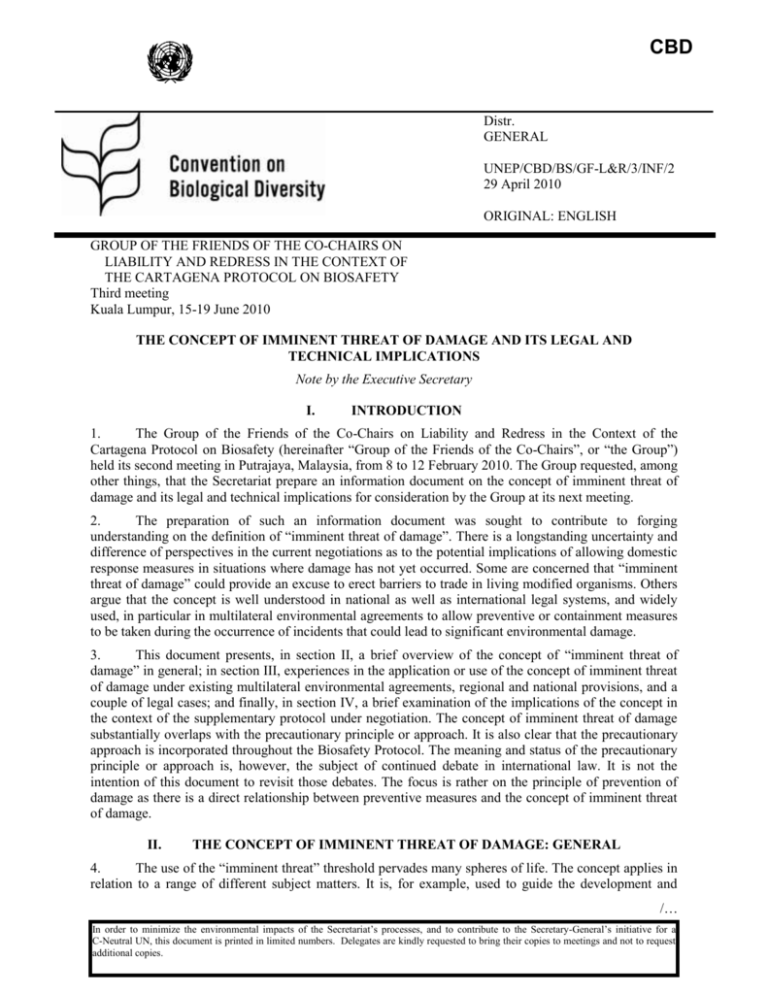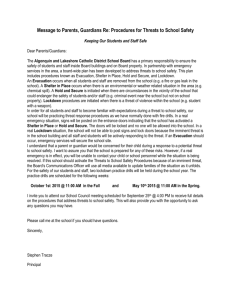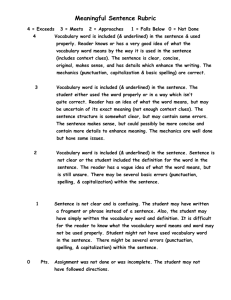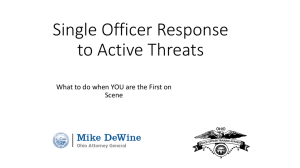II. THE CONCEPT OF Imminent threat OF DAMAGE: GENERAL
advertisement

CBD Distr. GENERAL UNEP/CBD/BS/GF-L&R/3/INF/2 29 April 2010 ORIGINAL: ENGLISH GROUP OF THE FRIENDS OF THE CO-CHAIRS ON LIABILITY AND REDRESS IN THE CONTEXT OF THE CARTAGENA PROTOCOL ON BIOSAFETY Third meeting Kuala Lumpur, 15-19 June 2010 THE CONCEPT OF IMMINENT THREAT OF DAMAGE AND ITS LEGAL AND TECHNICAL IMPLICATIONS Note by the Executive Secretary I. INTRODUCTION 1. The Group of the Friends of the Co-Chairs on Liability and Redress in the Context of the Cartagena Protocol on Biosafety (hereinafter “Group of the Friends of the Co-Chairs”, or “the Group”) held its second meeting in Putrajaya, Malaysia, from 8 to 12 February 2010. The Group requested, among other things, that the Secretariat prepare an information document on the concept of imminent threat of damage and its legal and technical implications for consideration by the Group at its next meeting. 2. The preparation of such an information document was sought to contribute to forging understanding on the definition of “imminent threat of damage”. There is a longstanding uncertainty and difference of perspectives in the current negotiations as to the potential implications of allowing domestic response measures in situations where damage has not yet occurred. Some are concerned that “imminent threat of damage” could provide an excuse to erect barriers to trade in living modified organisms. Others argue that the concept is well understood in national as well as international legal systems, and widely used, in particular in multilateral environmental agreements to allow preventive or containment measures to be taken during the occurrence of incidents that could lead to significant environmental damage. 3. This document presents, in section II, a brief overview of the concept of “imminent threat of damage” in general; in section III, experiences in the application or use of the concept of imminent threat of damage under existing multilateral environmental agreements, regional and national provisions, and a couple of legal cases; and finally, in section IV, a brief examination of the implications of the concept in the context of the supplementary protocol under negotiation. The concept of imminent threat of damage substantially overlaps with the precautionary principle or approach. It is also clear that the precautionary approach is incorporated throughout the Biosafety Protocol. The meaning and status of the precautionary principle or approach is, however, the subject of continued debate in international law. It is not the intention of this document to revisit those debates. The focus is rather on the principle of prevention of damage as there is a direct relationship between preventive measures and the concept of imminent threat of damage. II. THE CONCEPT OF IMMINENT THREAT OF DAMAGE: GENERAL 4. The use of the “imminent threat” threshold pervades many spheres of life. The concept applies in relation to a range of different subject matters. It is, for example, used to guide the development and /… In order to minimize the environmental impacts of the Secretariat’s processes, and to contribute to the Secretary-General’s initiative for a C-Neutral UN, this document is printed in limited numbers. Delegates are kindly requested to bring their copies to meetings and not to request additional copies. UNEP/CBD/BS/GF-L&R/3/INF/2 Page 2 application of measures for: work place safety; the safety of infrastructure such as buildings, installations and other operations such as mines; determining the proportionality of response actions to aggressions directed against an individual’s life or property or to national security; public health and medical practices; emergency response activities in relation to natural or man-made phenomena or exposure. Different expressions are used to describe the different consequences that may be caused by imminent threat. “Imminent threat of danger”, “imminent threat of hazard”, “imminent threat of harm”, “imminent threat of damage” are some of the common expressions, depending on the context in which they are used. However, as a matter of policy or legislative considerations, all these expressions have one thing in common, i.e. the intent to prevent danger, hazard, harm or damage. 5. The identification or recognition and management of imminent threat vary depending on the context within which the concept has been adopted or implemented. Some questions need to be answered in order to establish imminent threat of damage. Is the damage that may be caused by the threat significant, grave or serious? Is the risk of damage immediate or nearly so? The answers to these questions could provide an objective test to show imminent threat of damage. 6. The recognition of imminent threat of damage leads to response actions. It entails obligations on certain group of people or entities. These obligations could be procedural such as the requirement to notify an imminent threat of damage to public authorities or to people likely to be affected, or substantive actions to prevent or mitigate the damage. Depending on the policy environment and legal requirements, factors such as the cost of response measures as against the cost of damage may be taken into account to determine the appropriateness or feasibility of any particular response action. III. A. APPLICATION OR USE OF THE CONCEPT1 Multilateral agreements and arrangements 7. A number of multilateral agreements, in particular environment-related liability instruments, address, in one form or another, the concept of imminent threat of damage. It is a concept encapsulated in the subject of damage, which is central to almost all liability instruments. It is integral to the overall legal purpose of dealing with damage. Ultimately, the aim of those instruments that include the notion of “imminent threat of damage” or “imminent threat of causing damage” is to impose an obligation to take preventive measures that protect the environment, human life or property. 8. The 1969 International Convention Relating to Intervention on the High Seas in Case of Oil Pollution Casualties (Intervention Convention) is one of the earliest treaties to incorporate the concept. The Convention called upon Parties to take measures “as may be necessary to prevent, mitigate or eliminate grave and imminent danger to their coastline or related interests from pollution or threat of pollution of the sea by oil, following upon a maritime casualty or acts related to such a casualty, which may reasonably be expected to result in major harmful consequences”.2 Measures are expected to be proportionate to the damage by taking into account “(a) the extent and probability of imminent damage if those measures are not taken; (b) the likelihood of those measures to be effective; and (c) the extent of the damage which may be caused by such measures”.3 9. In 1973, the Intervention Convention was supplemented by a Protocol Relating to Intervention on the High Seas in Cases of Pollution by Substances other than Oil. The Protocol allows Parties to take similar action to that recognized under the Convention in cases of substances listed in the annex to the Protocol, and those other substances which are liable to create hazards to human health, to harm living 1 For ease of reference, a table is added at the end of this document showing the actual wording of the provisions or definitions of ‘imminent threat of damage’ and related notions in the various agreements, arrangements, or guidelines reviewed or referred to herein. 2 Paragraph 1 of Article I of the International Convention Relating to Intervention on the High Seas in Case of Oil Pollution Casualties, 1969, United Nations Treaty Series, vol. 970-I-14049 available: http://treaties.un.org/doc/Publication/UNTS/Volume%20970/volume-970-I-14049-English.pdf. 3 Ibid., at paragraph 3 of Article V. /… UNEP/CBD/BS/GF-L&R/3/INF/2 Page 3 resources and marine life, to damage amenities or to interfere with other legitimate uses of the sea.4 In the case of the latter category of substances, i.e. substances that are not listed, the Party taking action has the burden of establishing that the substance, under the circumstances present at the time of intervention, could reasonably pose a grave and imminent danger analogous to that posed by any of the listed substances.5 10. Other liability-related multilateral agreements6 that incorporate the concept of imminent threat of damage include: (a) Annex VI to the Protocol on Environmental Protection to the Antarctic Treaty – Liability Arising from Environmental Emergencies, 2005; (b) International Convention on Civil Liability for Bunker Oil Pollution Damage, 2001; (c) Basel Protocol on Liability and Compensation for Damage Resulting from Transboundary Movements of Hazardous Wastes and Their Disposal, 1999; (d) Convention on Supplementary Compensation for Nuclear Damage, 1997; (e) International Convention on Liability and Compensation for Damage in Connection with the Carriage of Hazardous and Noxious Substances by Sea, 1996; (f) Convention on Civil Liability for Damage Resulting from Activities Dangerous to the Environment (Lugano Convention), 1993; (g) International Convention on Civil Liability For Oil Pollution Damage, 1992;7 (h) Convention on Civil Liability for Damage Caused During Carriage of Dangerous Goods by Road, Rail And Inland Navigation Vessels (CRTD), 1990. 11. Most of these instruments provide for the definition of “preventive measures” as measures that need to be taken after the occurrence of an incident, and “incident” in turn is defined as “occurrence or serious of occurrences having the same origin that causes damage or creates a grave and imminent threat of causing damage”.8 Annex VI to the Protocol on Environmental Protection to the Antarctic Treaty – “Liability Arising from Environmental Emergencies” – presents a different formulation of the concept. Consistent with its title and purpose, the Annex defines “environmental emergency”. Accordingly, any accidental event that has occurred, and that results in, or imminently threatens, any significant and harmful impact on the Antarctic environment, constitutes an environmental emergency,9 which entails on each Party an obligation to require its operators to take prompt and effective response action.10 4 Paragraphs 1 and 2 of Article I, Protocol Relating to Intervention on the High Seas in Cases of Marine Pollution by Substances other than Oil, 1973, United Nations Treaty Series, vol. 1313, 1-21886, available: http://treaties.un.org/doc/Publication/UNTS/Volume%201313/volume-1313I-21886-English.pdf. 5 Ibid., at paragraph 3 of Article I. 6 For the status of these instruments, see the table in the annex to document UNEP/CBD/BS/GF-L&R/3/INF/1. 7 This is a consolidated text of the 1969 Civil Liability Convention as amended by the Protocol of 1992 (Protocol of 1992 to Amend the International Convention on Civil Liability for Oil Pollution Damage, 1969); 8 A similar approach has been adopted by UNEP in its “Guidelines for the development of domestic legislation on liability, response action and compensation for damage caused by activities dangerous to the environment” – see paragraphs 5 and 6 of Guideline 3, as adopted by the Governing Council through its decision UNEP/GCSS.XI/4 II of February 2010, under the item ‘environmental law’, available at: http://www.unep.org/gc/gcss-xi/working_docs.asp. 9 Article 2(b) of Annex VI to the Protocol on Environmental Protection to the Antarctic Treaty. 10 Paragraph 1 of Article 5. /… UNEP/CBD/BS/GF-L&R/3/INF/2 Page 4 12. A number of other multilateral agreements that do not have liability as their primary focus also require taking preventive measures when there is reason to believe that the processes, activities or substances in question are likely to cause harm to the environment or components of the environment.11 13. A state that becomes aware of cases in which the marine environment is in imminent danger of being damaged has an obligation to immediately notify other States it deems likely to be affected by such damage as well as the competent international organizations.12 14. The draft articles on the law of transboundary aquifers developed by the International Law Commission (ILC) contain a provision on emergency situations. “Emergency” is defined as “a situation, resulting suddenly from natural causes or from human conduct that affects a transboundary aquifer or aquifer system and poses an imminent threat of causing serious harm to aquifer States or other States”..13 In an emergency situation, the State from where the emergency originates has the duty to immediately notify other potentially affected States and competent international organizations, to take all practicable measures necessitated by the circumstances to prevent, mitigate and eliminate the harmful effect of the emergency.14 15. The ILC articles on the prevention of transboundary harm from hazardous activities15 apply to activities which involve risk of causing significant transboundary harm through their physical consequences.16 The State of origin is required to take all appropriate measures to prevent significant transboundary harm or at any event to minimize the risk thereof, 17 including providing the State likely to be affected with timely notification of the risk and the assessment as well as transmitting technical and all relevant information available, in the event assessment indicates a risk of causing significant damage. 18 There is a similar stipulation in the ILC principles on the allocation of loss in the case of transboundary harm arising out of hazardous activities19 of an obligation to promptly notify, consult with and seek cooperation of all States affected or likely to be affected upon the occurrence of an incident involving a hazardous activity which results or is likely to result in transboundary damage.20 16. The relevant provisions of the Convention on Biological Diversity and the Cartagena Protocol on Biosafety are reviewed in section IV below. B. Regional and national provisions 17. The fundamental principle of the European Union directive on environmental liability with regard to prevention and remedying of environmental damage, as stated in the preamble of the directive itself is “that an operator whose activity has caused the environmental damage or the imminent threat of such damage is to be held financially liable, in order to induce operators to adopt measures and develop practices to minimize the risks of environmental damage so that their exposure to financial liabilities is 11 See for example, (i) Article 3 of the 1996 Protocol to the London Convention on the Prevention of Marine Pollution by Dumping of Wastes and other Matter; (ii) Paragraph 1(4) of Article 1 of the United Nations Convention on the Law of the Sea (UNCLOS) of 1982; (iii) Article 2, Convention on Environmental Impact Assessment in a Transboundary Context (Espoo Convention), 1991. 12 Part XII, section 2, Article 198 of the United Nations Convention on the Law of the Sea. 13 Paragraph 1 of Article 17, resolution 63/124, “The law of transboundary aquifers” adopted by the General Assembly at its 63rd session (January 2009), available: http://www.internationalwaterlaw.org/documents/intldocs/UNGA_Resolution_on_Law_of_Transboundary_Aquifers.pdf. 14 Ibid., at paragraph 2 of Article 17. 15 Prevention of transboundary harm from hazardous activities, annex to resolution 62/68 adopted by the General Assembly, 6 December 2007. 16 Ibid., at Article 1. 17 Ibid., at Article 3. 18 Ibid., at Article 8. 19 Principles on the allocation of loss in the case of transboundary harm arising out of hazardous activities, annex to resolution 61/36 adopted by the General Assembly , 4 December 2006. 20 Ibid., at Principle 5. /… UNEP/CBD/BS/GF-L&R/3/INF/2 Page 5 reduced”.21 The directive defines “preventive measures” as “any measures taken in response to an event, act or omission that has created an imminent threat of environmental damage, with a view to preventing or minimizing that damage”.22 Operators are required to take preventive measures where there is an imminent threat of environmental damage.23 The directive further defines “imminent threat of damage” as “a sufficient likelihood that environmental damage will occur in the near future”.24 18. As part of the implementation process of the EU Environmental Liability Directive, some member States conducted public consultations and developed guidance documents to further the understanding of the requirements. For example, the draft guidance prepared by the Scottish Government for a second consultation elaborates the concept by describing some of the circumstances that constitute imminent threat of damage as follows: “An ‘imminent threat’ of ‘damage’ means that there is a sufficient likelihood that ‘damage’ will occur in the near future. This may include circumstances where: A damaging event has not yet occurred but is sufficiently likely to in the future and lead to ‘damage’ if action is not taken. For example, where a tank containing dangerous substances, which is situated near a major aquifer, is in very poor condition and is likely to leak without action to secure the tank. An event has occurred and there is no damage yet but there is a sufficient likelihood that ‘damage’ will occur in the near future if action is not taken. Extending the tank example above, this is where the tank has already started to leak and the substances have entered the soil and are likely to migrate to the aquifer without action to contain the contamination. Damage has occurred which is not yet ‘damage’ but is sufficiently likely to become ‘damage’ if action is not taken.25 Further extending the tank example above, this is where the tank has leaked and the contamination has already started to enter the aquifer. The damage does not yet qualify as water damage but without action to control further migration of contamination into the aquifer the damage is likely to become water damage.”26 19. The United States Environmental Protection Agency describes “imminent threat” as “a high probability that exposure is occurring”.27 C. Cases 20. In the Gabčíkovo-Nagymaros case,28 a dispute between Hungary and Slovakia over the construction of a dam on the River Danube, the International Court of Justice (ICJ) found that Hungary had not proved that a real “grave” and “imminent” peril existed in 1989, the year Hungary unilaterally suspended its part of the construction at Nagymaros on the grounds of “ecological state of necessity”, and that the measures taken by Hungary were the only response to it. The ICJ considered whether there was, 21 Paragraph 2 of the preamble to directive 2004/35/CE of the European Parliament and of the Council of 21 April 2004 on environmental liability with regard to the prevention and remedying of environmental damage. 22 Ibid., at paragraph 10 of Article 2. 23 Ibid., at paragraph 1 of Article 5. 24 Ibid., at paragraph 9of Article 2. 25 The reference to damage in quotation marks seems to refer to damage as defined in the Environmental Liability Directive. 26 Item 5.3, Environmental Liability (Prevention and Remediation) (Scotland) Regulations 2008: Draft Guidance, available at: http://www.scotland.gov.uk/Publications/2008/05/14161737/19. 27 United States Environmental Protection Agency, “Terms of Environment: Glossary, abbreviations and acronyms”, available at: http://www.epa.gov/OCEPAterms/iterms.html. 28 International Court of Justice, Case Concerning the Gabčíkovo-Nagymaros Project (Hungary/Slovakia), Judgment of 25 September 1997, available at: http://www.icj-cij.org/docket/files/92/7375.pdf?PHPSESSID=8633f6c82453d56be4798963f9436ee4 /… UNEP/CBD/BS/GF-L&R/3/INF/2 Page 6 in 1989, a state of necessity which would have permitted Hungary, without incurring international responsibility, to suspend and abandon works that it was committed to perform” in accordance with the treaty that both parties signed in 1977 concerning the construction and operation of the Gabčíkovo-Nagymaros System of Locks and related instruments. For the purpose of evaluating the existence of a state of necessity, the Court examined, following agreement by both Parties, Article 33 of the Draft Articles on the International Responsibility of States adopted by the International Law Commission (ILC) on its first reading,. The ILC draft article provides that “a state of necessity may not be invoked by a State as a ground for precluding the wrongfulness of an act of that State not in conformity with an international obligation of the State unless: (a) the act was the only means of safeguarding an essential interest of the State against a grave and imminent peril; and…..”29 21. The Court found that there were “uncertainties” concerning future harm to freshwater supplies and biodiversity as a result of the construction of the dam as Hungary argued in its pleadings. The Court, however, stated that: “Serious though these uncertainties might have been, they could not, alone, establish the objective existence of a ‘peril’ in the sense of a component element of a state of necessity. The word ‘peril’ certainly evokes the idea of risk; that is precisely what distinguishes ‘peril’ from material damage. But a state of necessity could not exist without a ‘peril’ duly established at the relevant point in time; the mere apprehension of a possible ‘peril’ could not suffice in that respect. It could moreover hardly be otherwise, when the ‘peril’ constituting the state of necessity has at the same time to be ‘grave’ and ‘imminent’. ‘Imminence’ is synonymous with ‘immediacy’ or ‘proximity’ and goes far beyond the concept of ‘possibility’. As the International Law Commission emphasized in its commentary, ‘the extremely grave and imminent’ peril must ‘have been a threat to an interest at the actual time’ (Yearbook of International Law Commission, 1980, Vol. II, Part 2, p. 49, para. 33). That does not exclude, in the view of the Court, that a ‘peril’ appearing in the long term might be held to be imminent as soon as it is established, at the relevant point in time, that the realization of that peril, however far off it might be, is not thereby any less certain and inevitable.”30 22. The Court noted that it was not convinced by the Hungarian argument on the state of necessity “unless it was at least proven that a real, “grave” and “imminent” “peril” existed in 1989 and that the measures taken by Hungary were the only possible response to it.31 23. The European Court of Justice rejected by majority in Balmer-Schafroth v. Switzerland the applicants’ claim that the failure of Switzerland to provide for administrative review of a decision extending the operation of a nuclear facility violated Article 6 of the European Convention on Human Rights. The Court ruled that the applicants failed to: “Establish a direct link between the operating conditions of the power station…and their right to protection of physical integrity, as they failed to show that the operation of Mühleberg power station exposed them personally to a danger that was not only serious, but also specific, and, above all, imminent. In the absence of such a finding, the effects on the population on the measures which the Federal Council could have ordered to be taken in the instant case therefore remained hypothetical. Consequently, neither the 29 Ibid., at paragraphs 49-50. 30 Ibid., at paragraph 54. 31 Ibid. Philippe Sands observes that this was “not a precautionary language premised as it is on the need to establish the certainty and inevitability of serious harm…..It may be that the ICJ also has this in mind that when in it indicated later in the judgment that ‘[w]hat might have been correct application of the law in 1989 or 1992, if the case had been before the Court then, could be a miscarriage of justice if prescribed in 1997”, in his book, Principles of International Law, second edition, Cambridge University Press, 2003, p. 275. /… UNEP/CBD/BS/GF-L&R/3/INF/2 Page 7 danger nor remedies were established with a degree of probability that make the outcome of the proceedings directly decisive.”32 IV. THE CONCEPT OF IMMINENT THREAT OF DAMAGE IN THE CONTEXT OF THE SUPPLEMENTARY PROTOCOL UNDER NEGOTIATION 24. The ultimate objective of all or most of the instruments or arrangements reviewed in the preceding sections is to prevent and/or remediate damage. Regardless of the different formulations under the different instruments and circumstances, the underlying rationale of the concept of imminent threat as a threshold for action to prevent or mitigate damage has been one of the regulatory approaches adopted invariably by these instruments with a view to meeting their objective. 25. The draft supplementary protocol is not different from the other instruments dealing with environmental damage or harm. It primarily aims to respond to and prevent damage resulting from the transboundary movements of living modified organisms. Inclusion of the concept of ‘imminent threat of damage’ in the draft supplementary protocol is one aspect of the prevention of damage. The supplementary protocol, as it stands now, defines ‘damage’ as an adverse effect on the conservation and sustainable use of biological diversity, taking also into account risks to human health, that is measurable or otherwise observable, and significant. The concept of imminent threat of damage introduces a further dimension to these elements of measurability and significance, i.e. ‘imminence’ arising from an ‘incident’ which in turn is defined as any occurrence or occurrences. 26. Since the supplementary protocol is being negotiated in the context of the Convention on Biological Diversity and the Cartagena Protocol on Biosafety, it is useful to examine some of the relevant rules and principles adopted by the parent treaties with a view to facilitating understanding and use of some of the important concepts such as damage and imminent threat of damage. 27. The Convention is based on, among other things, the principle of State responsibility not to cause damage to the environment of other States or of areas beyond the limits of national jurisdiction.33 It requires Parties to identify processes and categories of activities which have or are likely to have significant adverse impacts on the conservation and sustainable use of biological diversity.34 Environmental impact assessment is also a requirement for proposed projects that are likely to have significant adverse effects on biological diversity with a view to avoiding or minimizing such effects.35 Each Party has an obligation to promote notification, exchange of information and consultation on activities that are likely to cause significant adverse effects on biological diversity.36 In the case of imminent or grave danger or damage, there is a duty to immediately notify the potentially affected States and to initiate action to prevent or minimize such danger or damage.37 In terms of its purpose, this requirement is identical to the concept of imminent threat of damage that is being discussed in the context of the supplementary protocol. 28. There is also a similar requirement in the Biosafety Protocol in the case of unintentional transboundary movements of living modified organisms and emergency situations. Each Party is required to notify affected or potentially affected States and the Biosafety Clearing-House when there is a known occurrence resulting in a release of a living modified organism that leads or may lead to an unintentional transboundary movement that is likely to have significant adverse effects on the conservation and 32 Philippe Sands, Principles of International Law, second edition, Cambridge University Press, 2003, p. 278. 33 Convention on Biological Diversity (CBD), 1992, Article 3. 34 CBD, paragraph (c) of Article 7. 35 CBD, paragraph 1 of Article 14. 36 CBD, paragraph 1(c) of Article 14. 37 CBD, paragraph 1(d) of Article 14. /… UNEP/CBD/BS/GF-L&R/3/INF/2 Page 8 sustainable use of biological diversity, taking also into account risks to human health.38 In addition, each Party is to immediately consult the affected or potentially affected States to enable them to determine appropriate responses.39 29. The main concern expressed against the inclusion of the concept of imminent threat of damage in the supplementary protocol is its potential for use as a means to unduly restrict the import of living modified organisms. Parties to the Biosafety Protocol have already committed themselves to making informed decisions on the import of living modified organisms through the use of risk assessment to be carried out on a case-by-case basis and in a scientifically sound and transparent manner,40 and also agreed to the possibility of making decisions on the basis of precaution.41 30. In the context of the above, the supplementary protocol is, in fact, intended to be one of the important tools that help Parties to implement some of their core obligations such as the prevention or mitigation of damage to biological diversity as provided in the Convention as well as the Protocol. Table. Use of the concept of “imminent threat of damage” in international and regional agreements and guidelines ANNEX VI TO THE PROTOCOL ON ENVIRONMENTAL PROTECTION TO THE ANTARCTIC TREATY - LIABILITY ARISING FROM ENVIRONMENTAL EMERGENCIES (2005) Article 2 Definitions (b) “Environmental emergency” means any accidental event that has occurred, having taken place after the entry into force of this Annex, and that results in, or imminently threatens to result in, any significant and harmful impact on the Antarctic environment; Article 5 Response Action 1. Each Party shall require each of its operators to take prompt and effective response action to environmental emergencies arising from the activities of that operator. INTERNATIONAL CONVENTION ON CIVIL LIABILITY FOR BUNKER OIL POLLUTION DAMAGE (2001) Article 1 Definitions 7. “Preventive measures” means any reasonable measures taken by any person after an incident has occurred to prevent or minimize pollution damage. 8. “Incident” means any occurrence or series of occurrences having the same origin, which causes pollution damage or creates a grave and imminent threat of causing such damage. 9. “Pollution damage” means: (a) loss or damage caused outside the ship by contamination resulting from the escape or discharge of bunker oil from the ship, wherever such escape or discharge may occur, provided that compensation for impairment of the environment other than loss of profit from such impairment shall be limited to costs of reasonable measures of reinstatement actually undertaken or to be undertaken; and (b) the costs of preventive measures and further loss or damage caused by preventive measures. 38 Cartagena Protocol on Biosafety (BSP), 2000, paragraph 1 of Article 17. 39 BSP, paragraph 4 of Article 17. 40 BSP, paragraph 1 of Article 10; Article 15 and paragraphs 3 and 6 of Annex III. 41 BSP, paragraph 6 of Article 10 and paragraph 8 of Article 11. /… UNEP/CBD/BS/GF-L&R/3/INF/2 Page 9 BASEL PROTOCOL ON LIABILITY AND COMPENSATION FOR DAMAGE RESULTING FROM TRANSBOUNDARY MOVEMENTS OF HAZARDOUS WASTES AND THEIR DISPOSAL (1999) Article 2 Definitions (e) “Preventive measures” means any reasonable measures taken by any person in response to an incident, to prevent, minimize, or mitigate loss or damage, or to effect environmental clean-up; (h) “Incident” means any occurrence, or series of occurrences having the same origin that causes damage or creates a grave and imminent threat of causing damage; PROTOCOL TO AMEND THE 1963 VIENNA CONVENTION ON CIVIL LIABILITY FOR NUCLEAR DAMAGE (1997) Article 2 Article I of the 1963 Vienna Convention is amended as follows: 3. Paragraph 1(l) is replaced by the following text: (l) ”Nuclear incident” means any occurrence or series of occurrences having the same origin which causes nuclear damage or, but only with respect to preventive measures, creates a grave and imminent threat of causing such damage. CONVENTION ON SUPPLEMENTARY COMPENSATION FOR NUCLEAR DAMAGE (1997) Chapter 1 Article 1: Definitions (h) “Preventive measures” means any reasonable measures taken by any person after a nuclear incident has occurred to prevent or minimize damage referred to in sub-paragraphs (f)(i) to (v) or (vii), subject to any approval of the competent authorities required by the law of the State where the measures were taken. (i) “Nuclear incident” means any occurrence or series of occurrences having the same origin which causes nuclear damage or, but only with respect to preventive measures, creates a grave and imminent threat of causing such damage. INTERNATIONAL CONVENTION ON LIABILITY AND COMPENSATION FOR DAMAGE IN CONNECTION WITH THE CARRIAGE OF HAZARDOUS AND NOXIOUS SUBSTANCES BY SEA (HNS CONVENTION) (1996) Article 1: Definitions 6. “Damage” means: (d) the costs of preventive measures and further loss or damage caused by preventive measures. 7. “Preventive measures” means any reasonable measures taken by any person after an incident has occurred to prevent or minimize damage. 8. “Incident” means any occurrence or series of occurrences having the same origin, which causes damage or creates a grave and imminent threat of causing damage. /… UNEP/CBD/BS/GF-L&R/3/INF/2 Page 10 PROTOCOL FOR THE PROTECTION OF THE MEDITERRANEAN SEA AGAINST POLLUTION RESULTING FROM EXPLORATION AND EXPLOITATION OF THE CONTINENTAL SHELF AND THE SEABED AND ITS SUBSOIL (1994) Article 26 Transboundary pollution 3. If a Party becomes aware of cases in which the marine environment is in imminent danger of being damaged, or has been damaged, by pollution, it shall immediately notify other Parties which in its opinion are likely to be affected by such damage, as well as the Regional Marine Pollution Emergency Response Centre for the Mediterranean Sea (REMPEC), and provide them with timely information that would enable them, where necessary, to take appropriate measures. REMPEC shall distribute the information immediately to all relevant Parties. CONVENTION ON CIVIL LIABILITY FOR DAMAGE RESULTING FROM ACTIVITIES DANGEROUS TO THE ENVIRONMENT, LUGANO (1993) Article 2 Definitions 9. 9. “Preventive measures” means any reasonable measures taken by any person, after an incident has occurred to prevent or minimise loss or damage as referred to in paragraph 7, sub-paragraphs a to c of this article. 11. “Incident” means any sudden occurrence or continuous occurrence or any series of occurrences having the same origin, which causes damage or creates a grave and imminent threat of causing damage. INTERNATIONAL CONVENTION ON CIVIL LIABILITY FOR OIL POLLUTION DAMAGE, 1992 Article 1 For the purposes of this Convention: 7. “Preventive measures” means any reasonable measures taken by any person after an incident has occurred to prevent or minimize pollution damage. 8. “Incident” means any occurrence, or series of occurrences having the same origin as, which causes pollution damage or creates a grave and imminent threat of causing such damage. CONVENTION ON CIVIL LIABILITY FOR DAMAGE CAUSED DURING CARRIAGE OF DANGEROUS GOODS BY ROAD, RAIL AND INLAND NAVIGATION VESSELS (CRTD) (1989) Article 1: Definitions 11. “Preventive measures” means any reasonable measures taken by any person after an incident has occurred to prevent or minimize damage; 12. “Incident” means any occurrence or series of occurrences having the same origin, which causes damage or creates a grave and imminent threat of causing damage; /… UNEP/CBD/BS/GF-L&R/3/INF/2 Page 11 UNITED NATIONS CONVENTION ON THE LAW OF THE SEA (UNCLOS) (1982) Part XII Protection and preservation of the marine environment Section 2. Global and regional cooperation Article 198 Notification of imminent or actual damage When a State becomes aware of cases in which the marine environment is in imminent danger of being damaged or has been damaged by pollution, it shall immediately notify other States it deems likely to be affected by such damage, as well as the competent international organizations. Article 199 Contingency plans against pollution In the cases referred to in article 198, States in the area affected, in accordance with their capabilities, and the competent international organizations shall cooperate, to the extent possible, in eliminating the effects of pollution and preventing or minimizing the damage. To this end, States shall jointly develop and promote contingency plans for responding to pollution incidents in the marine environment. PROTOCOL RELATING TO INTERVENTION ON THE HIGH SEAS IN CASES OF POLLUTION BY SUBSTANCES OTHER THAN OIL (1973) Article I 3. Whenever an intervening Party takes action with regard to a substance referred to in paragraph 2 (b) above that Party shall have the burden of establishing that the substance, under the circumstances present at the time of the intervention, could reasonably pose a grave and imminent danger analogous to that posed by any of the substances enumerated in the list referred to in paragraph 2 (a). above. INTERNATIONAL CONVENTION RELATING TO INTERVENTION ON THE HIGH SEAS IN CASE OF OIL POLLUTION CASUALTIES (1969) Article I 1. Parties to the present Convention may take such measures on the high seas as may be necessary to prevent, mitigate or eliminate grave and imminent danger to their coastline or related interests from pollution or threat of pollution of the sea by oil, following upon a maritime casualty or acts related to such a casualty, which may reasonably be expected to result in major harmful consequences. Article V 3. In considering whether the measures are proportionate to the damage, account shall be taken of: (a) the extent and probability of imminent damage if those measures are not taken; and (b) the likelihood of those measures being effective; and (c) the extent of the damage which may be caused by such measures. DIRECTIVE 2004/35/CE OF THE EUROPEAN PARLIAMENT AND OF THE COUNCIL Article 2: Definitions 9. “imminent threat of damage” means a sufficient likelihood that environmental damage will occur in the near future; 10. “preventive measures” means any measures taken in response to an event, act or omission that has created an imminent threat of environmental damage, with a view to preventing or minimising that damage; /… UNEP/CBD/BS/GF-L&R/3/INF/2 Page 12 ILC DRAFT ARTICLES ON THE LAW OF TRANSBOUNDARY AQUIFERS (2008) Article 17 Emergency situations 1. For the purpose of the present article, “emergency” means a situation, resulting suddenly from natural causes or from human conduct, that affects a transboundary aquifer or aquifer system and poses an imminent threat of causing serious harm to aquifer States or other States. 2. The State within whose territory the emergency originates shall: (a) Without delay and by the most expeditious means available, notify other potentially affected States and competent international organizations of the emergency; (b) In cooperation with potentially affected States and, where appropriate, competent international organizations, immediately take all practicable measures necessitated by the circumstances to prevent, mitigate and eliminate any harmful effect of the emergency. UNEP GUIDELINES FOR THE DEVELOPMENT OF DOMESTIC LEGISLATION ON LIABILITY, RESPONSE ACTION AND COMPENSATION FOR DAMAGE CAUSED BY ACTIVITIES DANGEROUS TO THE ENVIRONMENT (2010) Guideline 3: Use of terms 5. The term “incident” means any occurrence or series of occurrences having the same origin that cause damage or create a grave and imminent threat of damage. 6. The term “preventive measures” means any reasonable measures taken by a person in response to an incident, to prevent, minimize or mitigate loss or damage, or undertake environmental clean-up. GUIDELINES ON LIABILITY AND COMPENSATION FOR DAMAGE RESULTING FROM POLLUTION OF THE MARINE ENVIRONMENT IN THE MEDITERRANEAN SEA AREA (FROM DECISION IG 17/4 OF THE 15TH MEETING OF THE CONTRACTING PARTIES (2008)) D. Damage 10. Compensation for environmental damage should include, as the case may be: (b) costs of preventive measures including measures to prevent a threat of damage or an aggravation of damage; G. Standard of Liability 22. For the purpose of these Guidelines, “incident” means any sudden occurrence or continuous occurrence or any series of occurrences having the same origin, which cause damage or create a grave and imminent threat of causing damage. ------








